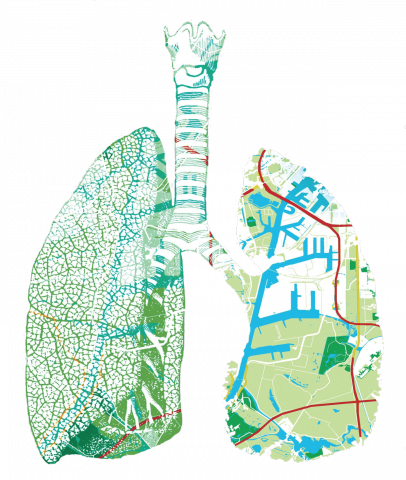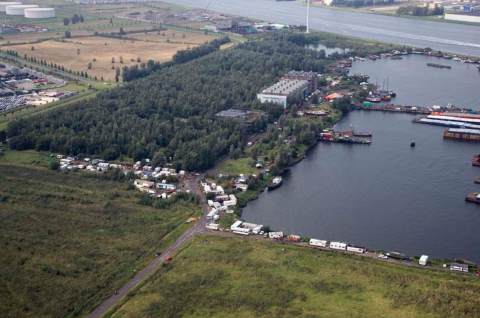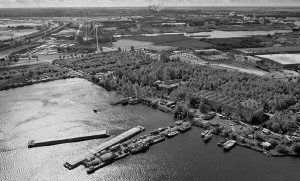 On the edge of an expanding industrial area in Amsterdam called Westpoort, a special development took place.
On the edge of an expanding industrial area in Amsterdam called Westpoort, a special development took place.
A group of people created a forest. The forest functions as a natural filter for emissions from local industries. It filters particulate matter, which are small particles of toxic debris and dust from the coal, concrete and petroleum industries located in the nearby area.
On the ADM terrain the trees and plants continually capture these small particles and hold on to them with their leaves and branches until they are washed away naturally by the rain. This is a pollution barrier at work.
The ADM trees also work as a sound barrier to the activity in the industrial freight and coal terminals located in the area. The trees also capture and store CO2 gas. This sound barrier, natural air filter and CO2 storage works every day.
At present the ADM forest forms a direct benefit for the surrounding living areas such as Westzaan and Zaandam, but also for the environment in a much bigger sense.
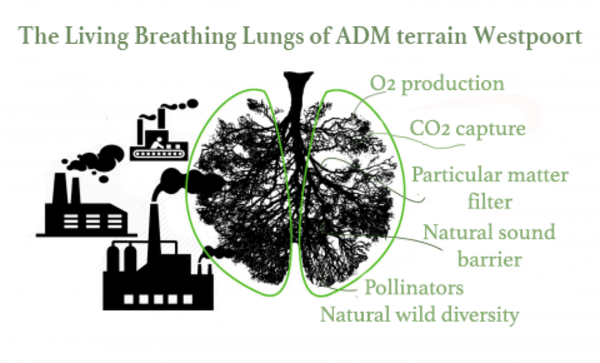 Location and Surroundings
Location and Surroundings
The ADM terrain is situated next to some of the biggest freight and logistics companies in Amsterdam, such as OBA Bulk Terminal Amsterdam (coal, steel & chemical industry), BP Terminal (petroleum wholesale) and Waterland Terminal BV (freight logistics). These are but a few of the companies who are situated within the range of the ADM terrain (3 km or less).
These companies have to monitor all of their emissions, including CO2, and have to make sure they do not exceed their limits, even more so now that a new energy strategy of the Amsterdam Klimaatbureau for 2040 is in place. This strategy is an energy plan for the city and ports of Amsterdam.
The City of Amsterdam Klimaatbureau operates within the policies that are set by the European Union, which determines limits for pollution; gasses; particulate matter production; the protection of nature; cleaning the water tables of rivers, lakes and seas for the whole of Europe.
The Amsterdam Klimaatbureau scheme for 2040 states; “The Port Authority has committed to (a reduction of) 40% of CO2 by 2025 and this includes inland and ocean shipping” and “in addition to cleaning up (coal and oil)… energy use in the port must be made more sustainable…. Sustainable innovative companies (recycling systems, bio fuels, transshipment and wind turbines) will set up business in the port.”
We ask the Amsterdam Klimaatbureau this:
How is it possible to clear a forest full of natural habitat (water, birds, trees, plants and shrubs), all of which are working to capture CO2 and filter emissions in an area which is constantly increasing in biodiversity with an active natural sound barrier, while at the same time boasting about reducing emissions in their new energy scheme?
It seems that there is no awareness of what has been unfolding on the ADM terrain. The Amsterdam Klimaatbureau document clearly states that becoming greener is better and how companies have to be environmentally conscious if they are to develop at the port.
What are they doing to enforce this?
ADM asks for support from the Amsterdam Klimaatbureau to recognize the importance of the 20 year old forest and what it actually does (CO2 capture; emissions and water filtration; sound barrier; nesting for birds, insects, pollinators and amphibians).
The EU strategy for the protection of natural habitats is known as the Council Directive 92/43/EEC on the Conservation of natural habitats and of wild fauna & flora. This directive is an important legal standard that was set in 1992 to ensure the protection of biodiverse areas such as the ADM terrain.
How is it possible for the Amsterdam Klimaatbureau and council to ignore Council Directive 92/43/EEC and grant a permit to a company which has a total disregard for nature and support the destruction of a natural nesting habitat with protected plants and wildlife?
Birds like the King Fisher and birds of prey like the Buzzard are protected by the Birds Directive formally known as Council Directive 2009/147/EC on the conservation of wild birds. Amphibians like the Natter Jack toad are listed as well. All these animals have been documented and certified by ecologists to have nests in the area that was cleared. Again, how is this possible?
The ADM forest, trees and plants
The front part of the ADM terrain previously consisted of a mix of mature trees, young saplings and plants and shrubs essential for wildlife and the cleaning up of local emissions. The companies Chidda Vastgoed BV / Amstelimmo BV and Koole Maritiem BV attempted to cut these trees during the nesting season, between April and May 2015. They were stopped by the residents of ADM and the police as they failed to present their permits.
However, in August 2015 they cut around 2,000 trees at the front part of the ADM terrain illegally. Also, there was no compensatory C02 emissions plan for the area they cleared. This means that there was no effort made to replant trees and shrubs in the nearby surroundings.
The animals and birds that were nesting were not considered with enough respect and also the Natterjack yellow stripe toad, which is a protected listed amphibian, was not taken seriously. Proof of this toad’s nesting habitat was clearly made and represented in several environmental reports.
Shockingly, Chidda and the company Koole Maritiem managed to receive a further permit to cut 470 trees which were over 10 cm in diameter and more than 1000 trees which were under 10 cm. They manged to receive this permit after they had already cut some trees which were not on the permit.
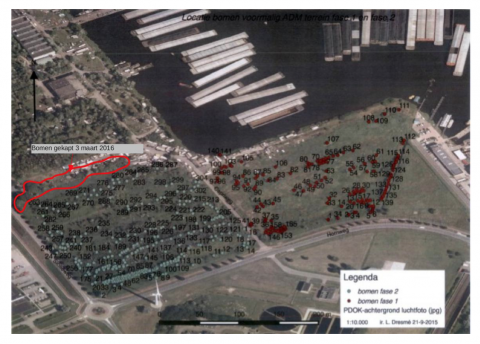
(This is an aerial photograph of the trees they were allowed to cut. The trees within the red loop are the one’s they cut illegally)
Furthermore, none of the proposed building plans of Chidda were executed. This is a breach of the ‘Just in time policy’. This policy came into effect on 13th of May 2009. It serves to ensure that companies do not get the right to cut down trees and flatten wild terrain until they have clear building plans, which then have to be carried out. The policy also serves to protect animals and wildlife. This is a council policy which is notoriously difficult to access, although it does exist for the above reasons. Therefore it should be publicly accessible.
Tree facts and info
An area with 2,000 trees, where each tree has a potential to consume 45lbs of CO2 per year, should have an adequate replanting and regeneration scheme. This is known as a carbon offset and should be implemented by the company that is responsible for felling the trees.
This is common practice by companies that consciously look after the environment.
The felling of 2,000 mature trees equals the loss of a cleaning potential of 90,000lbs of C02, which is 45 tonnes of stored CO2 per year.
In October 2016 Chidda and Koole applied for a permit to cut 10,000 trees inside the gate of the ADM terrain. Currently the 10,000 trees that are left on the ADM terrain have the potential to capture 450,000lbs of C02, equal to 225 tonnes of CO2 per year (source: Arbor Environmental Alliance).
Thankfully, the permit which Chidda and Koole applied for was rejected by the council on the basis of bad practice and the absence of a clear plan for development by the companies involved.
If the companies receive the permits to cut down all the trees within the community, this would clearly indicate that there is no environmental policy enforcement being upheld in the Westpoort harbor of Amsterdam.
The 20 year old ADM forest needs to be recognized and protected.
In January 2017 Chidda and Koole received a permit to ‘prune’ the trees around the lake behind the ADM terrain. They abused their permit by tearing trees down with heavy machinery. Fortunately they were stopped by the authorities.
In March this year they applied for another permit to cut the trees around the lake, regardless of the fact that the nesting season is beginning.
Summary
The nature on the ADM terrain shows us how recovery from industrial waste and destruction is possible. The forest grows and natural diversity is being generated every day. The community living there has supported this development.
ADM is a beautiful example of the symbiosis between nature and humans and it is unique in many ways.
It’s time to clean up, breathe fresh air, drink clean water and grow food on a cleaner, greener and, ideally, unpolluted earth.
Join our fight against Chidda’s development plans and help support the cleaner greener environment that we should all live in. Any support is welcome.
More in depth info? Check these links:
• The Amsterdam Kilimaatbureau publication on the 2040 Energy strategy
• Here is a video from news station AT5 of the action that was made against the protection of the ADM on the 28th of August 2015. This is an illegal action by companies Chidda and Koole caught on camera where a persons life was put in danger.
• Council Directive 92/43/EEC on the Conservation of natural habitats and of wild fauna and flora
• Council Directive 2009/147/EC on the conservation of wild birds
• For more information on European Environmental Policies
• This is a link to an audio interview of the full story of what happened on the days Chidda / Koola decided they would take matters into their own hands and clear all the front part of the ADM terrain.
• Arbor Environmental Alliance has a website with lots more information about why trees are so important.
• Here is a more in-depth study of the biodiversity that exists on the ADM terrain made (by Norbert Daemen of nature advice bureau Arda)
ADM
Hornweg 6, 1045AR Amsterdam, Netherlands
https://adm.amsterdam/
Authors of this article: Chin, Lisette and Cjara
Bron: https://adm.amsterdam/article/article-amsterdamalternative-edition-aprilmay-published-online-april-21st-2017-living

